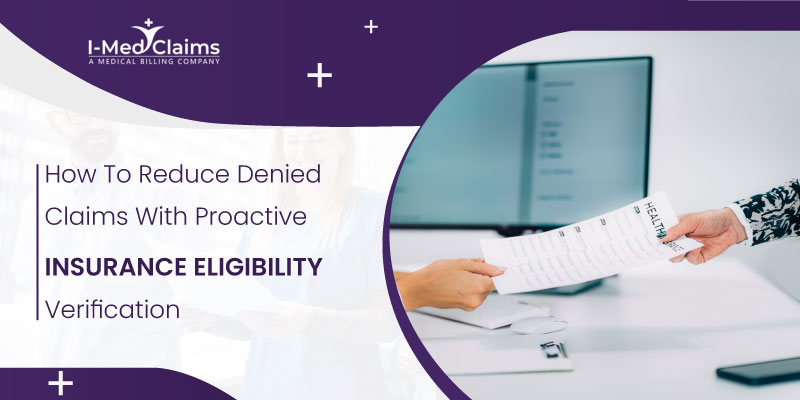Insurance eligibility verification determines a patient’s insurance eligibility based on three different status updates: coverage status, active or inactive status, and eligibility status. Insurance eligibility verification is critical since it is directly related to claim denials or payment delays in healthcare practice, particularly the account receivables (A/R).
Checking a patient’s insurance eligibility and benefits is a necessary initial step before submitting an insurance claim to a clearinghouse and insurance payers. Patient eligibility verification is one of the simplest ways to keep clean claims, yet it is sometimes the most overlooked step.
Eligibility verification verifies that insurance data is accurate and assists in determining how much a patient may spend (e.g., co-pays, co-insurance, and deductibles). Offering more precise cost estimation to your patients can increase patient satisfaction and prevent you from future claim denials. Healthcare providers should establish proper management for medical billing services to be reimbursed for services provided. Clean claims filing is a critical component of effective medical billing services. Practice can verify that each claim is prepared for success after a patient schedules an appointment with a robust insurance eligibility verification procedure.
Why Are Claims Rejected?
Eligibility verification is one of the revenue cycle’s first and most essential elements. Did you know that eligibility issues are among the top five reasons for claim denials? In reality, nearly 24% of claims are refused due to eligibility and registration concerns, such as the patient not being entitled to health benefits on the date of service or having inaccurate demographic data, such as a spelling error or date of birth.
The eligibility verification procedure is directly related to claim denials, which can have a range of adverse outcomes. That includes an increase in the number of days in A/R, an increase in write-off rates, a stop in cash flow, increased collection expenses, and delays in a patient’s access to treatment. Verifying eligibility must be rapid and precise to evaluate the duties of both payer and patient.
Eligibility Verification Tips
TIP 1: Ensure that the insurance information is accurate by verifying the insurance plan policy coverage and term dates with the insurance payer (through phone or insurance websites). Make a note of the reference call number in your documents. Examine the patient’s eligibility at least 5-7 days before the first visit. Please don’t wait until you’ve filed the claim because many faults can’t be fixed after they’ve occurred. Carefully check the patient’s insurance card at the time of arrival to ensure that you have the appropriate insurance plan.
TIP 2: Get prior authorization for certain services from the insurance payer and a primary care provider (PCP) recommendation. Check claim to ensure the validation of previous approval and referral number(s).
TIP 3: If the patient has insurance, confirm that the coverage for tests and materials is active. If the patient does not have insurance, go through a process to inform them of their financial responsibilities.
Suppose you anticipate that Medicare will not cover an operation or service. In that case, you must acquire an Advance Beneficiary Notice (ABN) before performing the procedure or service on the patient.
TIP 4: It is always preferable to contact the insurance provider to confirm details on each patient’s insurance card. Even after the card has been given, the insurance coverage data may be modified. You can accomplish this by calling the helpline listed on the card, or in the case of significant payers, by connecting them using your Combined EMR and Billing system.
TIP 5: Confirm patient’s out-of-pocket insurance payments, co-pays for exams, and materials for insurance plans. Inform the patient of their financial obligations upfront.
Advantages Of Patient’s Eligibility Verification
A patient’s eligibility for insurance and benefits is one of the essential tasks of front desk staff before any healthcare services are delivered. It necessitates competent and experienced personnel capable of handling insurance difficulties and carrying out the same process with maximum precision. Following are the advantages of patient eligibility verification.
Improved Profitability
When a proper and up-to-date verification is performed, the claim submission is clean. There are fewer claim denials, which keeps healthcare’s cash flow stable.
Significantly Lower Claim Denials and Rejections
When the verification system is precise and streamlined, the filing of clean claims improves, which aids in the reduction of claim denials and rejections.
Efficient Workflow
Insurance services improve healthcare organizations’ revenue cycle management. Smooth workflow promotes a positive patient experience and reduces claim denials moderately.
Increased Patient Satisfaction
Proper verification of patient eligibility reduces claim denials or resubmissions, enhances patient outcomes, and improves patient satisfaction levels.
Verifying your patient’s eligibility and benefits is critical to sustaining an income stream. Knowing that your billing is managed expertly can eventually drive your business and provide consistent cash flow. If you fail to verify insurance eligibility and benefits up front, you risk creating unhealthy and substantial income difficulties later on. Our professionals combine cutting-edge technology with years of experience in healthcare revenue management. We help eliminate denied claims and boost your practice’s bottom line by validating patients’ insurance and correcting billing and coding issues before they become a problem. An accurate eligibility process can reduce the number of denied claims. Contact us today to get started.


